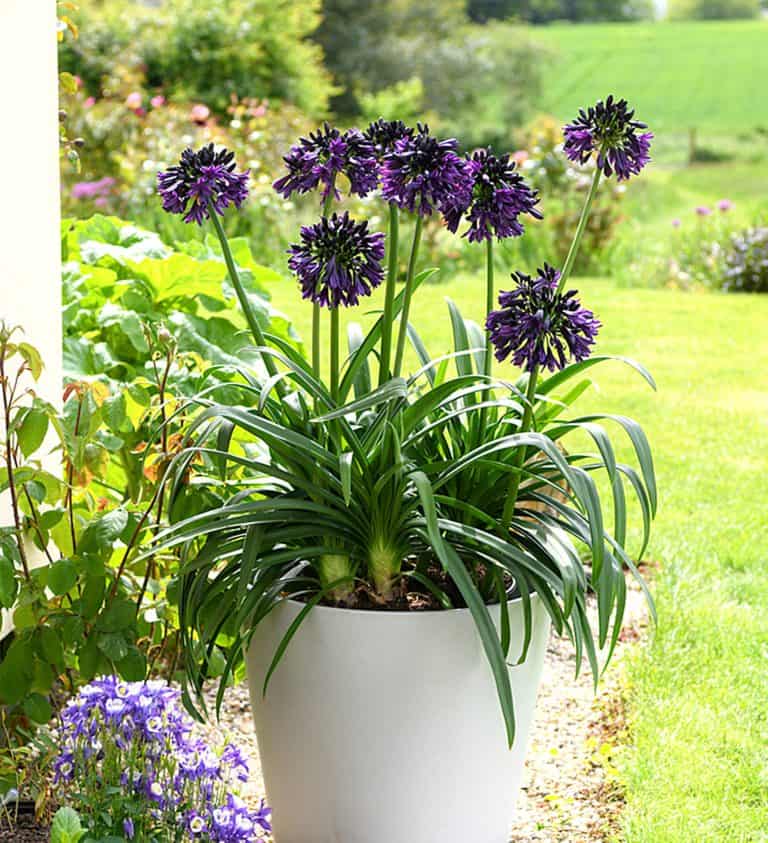Exactly how to Plant and Maintain Agapanthus in Your Yard
Exactly how to Plant and Maintain Agapanthus in Your Yard
Blog Article
Understanding the Art of Agapanthus Care: Crucial Steps for Healthy And Balanced Development and Dynamic Blooms
In the realm of gardening, the farming of agapanthus stands as a fulfilling endeavor for those who seek to support these stylish blooming plants. With their striking blossoms and elegant vegetation, agapanthus has actually recorded the focus of garden enthusiasts worldwide. Nonetheless, achieving ideal growth and dynamic blossoms requires a nuanced technique that includes different vital steps. From selecting the appropriate variety to understanding trimming strategies, the journey towards growing flourishing agapanthus plants is multifaceted and holds the crucial to unlocking the complete capacity of these agricultural gems.

Choosing the Right Agapanthus Range

When choosing the best Agapanthus variety for your yard, think about variables such as environment suitability, bloom shade, and growth behavior. Furthermore, think about the climate in your region to guarantee the Agapanthus selection you choose can flourish in your details problems. Recognizing the development habit of various Agapanthus varieties is critical for appropriate positioning within your yard.
Suitable Growing Conditions
Considering the optimum environmental requirements is important for successful Agapanthus farming. Agapanthus plants are delicate to chilly temperature levels and must be protected from frost during winter months.
To make sure healthy and balanced growth and dynamic blossoms, plant Agapanthus bulbs at a depth of about 2-4 inches and space them 8-12 inches apart. Including natural issue, such as garden compost, to the soil can boost drainage and fertility, advertising durable root development. Mulching around the base of the plants assists maintain wetness and reduces weed development. Regular watering is essential, specifically throughout the growing period, to keep the dirt regularly wet however not saturated.
Watering and Feeding Tips
Maintaining correct wetness degrees and offering important nutrients are essential components in the treatment program for Agapanthus plants. When it comes to watering Agapanthus, it is essential to strike a balance. These plants like consistently moist dirt yet are prone to root rot if overwatered.
Fertilizing Agapanthus is necessary for promoting healthy growth and respected blooms. Use a balanced fertilizer, such as a 10-10-10 formula, in the early springtime as new development emerges. Repeat this application every 6-8 weeks throughout the growing period. Prevent excessive fertilizing, as it can result in lush vegetation at the cost of blossoms. Always follow the maker's directions for appropriate dilution and application approaches. By adhering to these watering and fertilizing ideas, you can guarantee your Agapanthus plants grow and produce vivid, long-lasting blooms.
Trimming Techniques for Agapanthus
Trimming Agapanthus plants at the appropriate times and with appropriate methods is critical for preserving their wellness and promoting optimum growth and blooming. The excellent time to prune Agapanthus remains in late winter months or early spring prior to brand-new development emerges. Beginning by eliminating any yellowing or dead fallen leaves near the base of the plant. Cut them more as close to the ground as possible without damaging the arising shoots.
For flowered stems, wait up until the blooms have actually perished and then trim them back to the base. This not just cleans the plant's appearance however additionally encourages the advancement of new blossom buds. Deadheading spent blossoms can additionally redirect the plant's energy into generating even more blooms instead of establishing seeds. Nonetheless, if you intend to gather seeds for breeding, leave some blossoms to completely dry and fully grown on the plant.
Bear in mind to make use of tidy, sharp tools to More about the author make specific cuts and decrease the danger of presenting illness. Agapanthus. Normal pruning will aid maintain your Agapanthus looking cool and healthy and balanced while making sure a bountiful display of lovely blooms
Taking Care Of Typical Parasites and Conditions
After guaranteeing appropriate trimming methods for Agapanthus, it is crucial to deal with common bugs and conditions that can influence the wellness and vigor of these plants. One typical bug that influences Agapanthus is the Agapanthus gall midget.
Another typical problem is fungal fallen leave place, which provides as dark lesions on the fallen leaves. To avoid fungal illness, make certain great air blood circulation around the plants, stay clear of overhead watering, and remove any kind of infected fallen leaves without delay. Additionally, Agapanthus plants can deal with root rot if they are grown my company in badly draining dirt. To prevent this, plant Agapanthus in well-draining dirt and stay clear of overwatering. By being watchful and taking timely action versus pests and illness, you can help your Agapanthus plants thrive and generate dynamic flowers.

Conclusion
To conclude, understanding the art of agapanthus treatment includes selecting the right range, offering optimal planting problems, correct watering and fertilizing, suitable trimming strategies, and resolving common bugs and illness. By following these important steps, you can make sure healthy and balanced development and vibrant blooms for your agapanthus plants. Keep in mind to consistently monitor and maintain your plants to advertise their overall well-being and durability.
To make certain healthy development and dynamic blooms, plant Agapanthus light bulbs at a depth of concerning 2-4 inches and room them 8-12 inches apart. By complying with these watering and fertilizing pointers, you can ensure your Agapanthus plants grow and produce vibrant, long-lasting flowers.
One usual bug that impacts Agapanthus is the Agapanthus gall midge. Furthermore, Agapanthus plants can suffer from root rot if they are grown in badly draining dirt. By adhering to these necessary steps, you can guarantee healthy development and dynamic blooms for your agapanthus plants.
Report this page